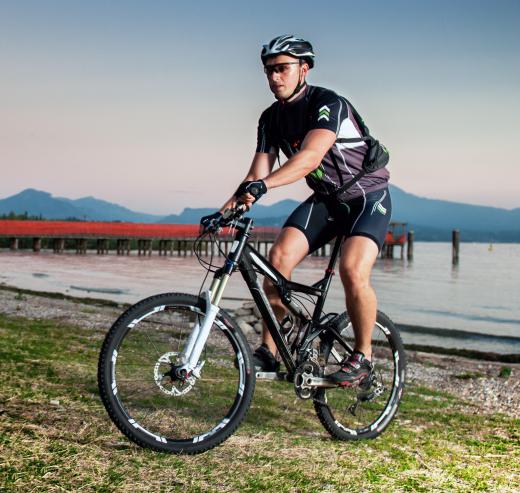At Sports&Hobbies, we're committed to delivering accurate, trustworthy information. Our expert-authored content is rigorously fact-checked and sourced from credible authorities. Discover how we uphold the highest standards in providing you with reliable knowledge.
Why Isn't It Harder to Balance on a Bicycle?
Although many frustrated but undaunted five-year-old children may disagree, it is remarkably easy for most people to balance on a bicycle. Professional stunt riders can literally perform tricks on every part of a modified bicycle without touching the ground or even pedaling. Once a bicycle and rider take off from a stationary position, it seems like the bike becomes surprisingly stable in a short amount of time.
So why isn't it harder to balance on a bicycle than it apparently should be? The answer lies in the nature of balance and a few laws of physics. The most difficult part of learning to ride a bicycle for many people is creating enough momentum through pedaling in order to allow the bike to stabilize itself. Once a rider learns how to mount a bicycle and distribute his or her weight, the rest is up to the natural physics of the wheels, seat, pedals, brakes and handlebars.

A bicycle contains two wheels in a straight alignment. At first, this would appear to make it much harder to balance, but physics actually make it easier. When a structure like a revolving wheel starts spinning in one direction around a central axis, it wants to continue moving in that direction. At a certain speed, centrifugal force takes over and makes it extremely difficult to push or pull that wheel in another direction. In the case of a spinning bicycle wheel, the resistance created by centrifugal force is much stronger than gravity's pull towards the ground. As long as the tires are spinning and facing the same direction, it is much easier to balance on a bicycle than use force to make it fall.

Another reason it's easy to maintain proper balance on a bicycle is the position of the seat and pedals in relation to the wheels. A bicycle's center of gravity is very close to the seat and in a line above the pedals. When a rider mounts a bicycle and distributes his or her weight across the seat, frame and handlebars, he or she is positioned right at the center of gravity. This is the same principle of balance which allows tightrope walkers to move across a thin wire with a weighted pole. When a rider becomes perfectly balanced over the center of gravity, he or she only needs to make small adjustments in order to steer into a turn or change direction.

If a bicycle's tires were offset instead of perfectly aligned, or the seat were located far ahead or behind the center of gravity, it would indeed be difficult to balance on a bicycle. A bicycle becomes stable only when it takes advantage of the natural laws of physics and the principles of balance. A unicycle is notably less stable than a bicycle, but the rider still benefits from sitting directly over the center of gravity and creating centrifugal force through pedaling.
AS FEATURED ON:
AS FEATURED ON:














Discussion Comments
I was fitted for my bike, with the seat up high enough that my knees were in the proper position, but the problem is when I try to start off, I can't get up and going very well. I have fallen a few times trying to get going, because my feet hardly touch.
Also, once I finally get going, I can't seem to ride straight; I tend to swerve a lot. Is there something to help with balance within my body?
I believe it has something to do with the caster/camber of the front wheel.
Centrifugal force does not exist. Centripetal force creates acceleration towards the center of the circle.
Centrifugal force is the major factor. If one is falling towards the right, turning the handlebars in that direction will cause the bicycle and rider to turn to the right, which creates an arc to the right. This arcing to the right creates centrifugal force which, reacting against the contact patch of the tires, forces the bicycle to an upright position. The faster one travels, the larger the radius of the arc is. At sufficient speed, the radius becomes almost infinite.
This is why roller-riding is so much more difficult than road riding. This centrifugal force is missing, only the rather minor gyroscopic effect of the wheels is there, and it really does become a matter of rider balance.
Centrifugal force (gyroscope effect) of spinning wheels has no effect on the rear wheel and almost none on the front. And the center of gravity plays a role in balance only from side to side, not front to back.
centrifugal force is too weak to aid in balance, especially at low speeds on a bicycle. -wle.
What you don't want to do is cross your hands and try to ride a bike, like I did when I was young. It resulted in immediate calamity. I caught the pavement, fell off and broke my wrist. That was bad enough, but I did it in front of the bus queue - much worse. --Mike
Try riding a bicycle with the handlebars locked - it's almost impossible. The real reason that you are able to balance is because of the continuous handlebar adjustments which (once you have learned to ride) you make subconsciously all the time. If you start to fall say to the right, a slight right turn on the handlebars puts you back upright again.
What a very cool question and a great answer!
Post your comments